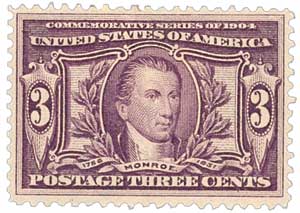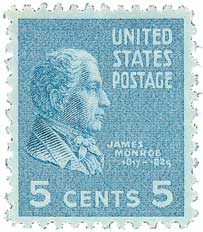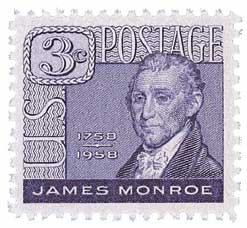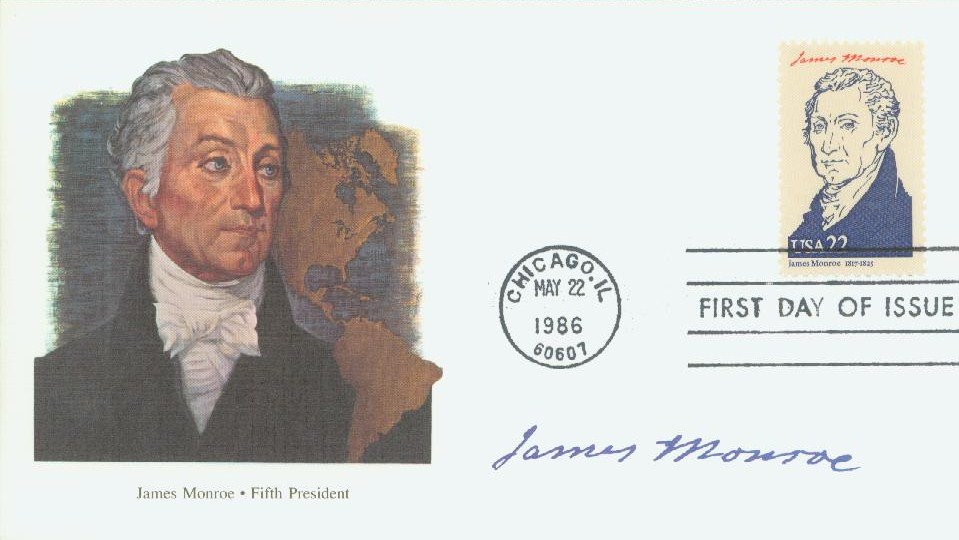
# 2216e FDC - 1986 22c Pres. Monroe,single
Birth Of James Monroe

James Monroe was born in Westmoreland County, Virginia, on April 28, 1758, to successful Virginia plantation owners.
When Monroe was a teenager, both of his parents died, leaving him the family tobacco farm. After attending the Campbelltown Academy, Monroe enrolled in Virginia’s College of William and Mary at the age of 16.
Monroe and his classmates quickly became involved in revolutionary activities. In one instance, he and his classmates raided the arsenal at the British Governor’s Palace with 24 older men. The young revolutionaries captured 200 muskets and 300 swords, which they gave to the Virginia militia.

In 1776, Monroe dropped out of college to become an officer in the Continental Army. He joined General George Washington’s army at New York, where he was shot in the shoulder at the Battle of Trenton. Monroe continued fighting despite his life-threatening injury, and eventually received promotions to captain and then major. Following his promotion, Monroe joined the staff of General William Alexander, where he served for over a year. In 1779, Monroe resigned his post in the Continental Army to study law, but was later commissioned as colonel in the Virginia service.
Once the war was over, Monroe studied law with Thomas Jefferson and was elected to the Virginia House of Delegates. After his election to the Continental Congress in 1783, Monroe met Elizabeth Kortright, who he married in 1786. Shortly after the wedding, the couple moved to Fredericksburg, Virginia, where Monroe began his law practice.

Monroe served in the Continental Congress until 1786, when he joined the Virginia assembly and was selected to join the Anti-Federalists at the Virginia Convention to debate the Constitution. Monroe initially voted against the ratification, calling for the direct election of presidents and senators and a bill of rights. The first ten amendments, which are known as the Bill of Rights, were suggested by Monroe and passed shortly after ratification.
In 1790, Monroe was appointed to the U.S. Senate, where he worked closely with James Madison and Thomas Jefferson. Four years later, President Washington sent Monroe to Paris as the U.S. minister to France. Despite his sympathies for the French revolutionaries, Monroe remained a neutral force for the United States.
Monroe returned to the U.S. in 1797, and in 1799 began his first of three one-year terms as governor of Virginia. In 1803, President Thomas Jefferson sent Monroe to France to help negotiate the Louisiana Purchase. Monroe remained in Europe until 1807, serving as U.S. minister to Britain. Following his return, Monroe was again elected governor of Virginia, but chose to return to Washington, D.C., to serve as secretary of state, and at one point, secretary of war, until 1817.

Following President James Madison’s decision to continue the two-term custom, the Democratic-Republicans turned to James Monroe as the ideal candidate for the presidency in 1817. Monroe’s victory over Rufus King in the Electoral College won him the presidency.
Monroe began his term in office with a 15-week presidential tour through the northern states, making him the most visible sitting President. Monroe was so well received in Boston that one newspaper wrote that it was the beginning of the “Era of Good Feelings” for America. The nation’s success in the War of 1812, coupled with the booming economy, allowed Monroe to focus on domestic issues.
Despite Monroe’s popularity and the general optimism of the American public, not all circumstances could be predicted. Early in his term, the Panic of 1819 (likely caused by the boom-bust cycle common today) led to widespread unemployment, foreclosures, and bankruptcies. Although this situation was common for a new economy, there was little the President could do to reduce the strain on the nation.
Within the same year, Monroe was faced with another crisis. The Missouri territory was soon to be admitted to the Union, but its status as a slave state would have thrown off the legislative balance between the North and the South. As a result, Congress negotiated with Massachusetts to admit the northern counties of the state as the new free state of Maine, retaining the balance between free and slave states. The Missouri Compromise also required that western territories in the Louisiana Purchase (above the 36/30’ north latitude line) prohibit slavery. President Monroe, who supported the compromise, ensured that it was constitutional and signed the bill admitting the two new states to the Union.

In 1818, General Andrew Jackson led the capture of two Spanish forts located in Florida, proving the lack of Spanish control in the territory. Monroe and his secretary of state, John Quincy Adams, used this vulnerability to convince Spain to sell Florida to the U.S. As a result, Spain’s control in the Americas began to diminish.
In response to this, neighboring European countries issued threats of an alliance to help Spain retake control of its former territories in the Americas. Monroe’s friends and colleagues Thomas Jefferson and James Madison urged him to accept the British offer of an alliance against France and Spain. Monroe chose instead to follow the advice of John Quincy Adams, who believed America should not be influenced by European encroachments.

On December 2, 1823, President Monroe addressed Congress with what would later be called the Monroe Doctrine. In his speech, Monroe declared to the other major world powers that America would no longer be accessible to European colonization. If any European country attempted to impress political influence on America, it would be seen as “dangerous to our peace and safety.” Monroe also stressed that America would stay out of European wars and internal affairs, and expect the same from them.
At the end of his second term, and after more than 40 years serving the public, Monroe and his wife retired to their estate in Virginia. Deeply in debt from his years in public service, Monroe requested that the government ease his financial burden by repaying him for past services. They eventually obliged, paying him a portion of what he requested. Following his wife’s death in 1830, Monroe moved to New York City to live with his daughter Maria. On July 4, 1831, James Monroe became the third U.S. President to die on Independence Day.
Birth Of James Monroe

James Monroe was born in Westmoreland County, Virginia, on April 28, 1758, to successful Virginia plantation owners.
When Monroe was a teenager, both of his parents died, leaving him the family tobacco farm. After attending the Campbelltown Academy, Monroe enrolled in Virginia’s College of William and Mary at the age of 16.
Monroe and his classmates quickly became involved in revolutionary activities. In one instance, he and his classmates raided the arsenal at the British Governor’s Palace with 24 older men. The young revolutionaries captured 200 muskets and 300 swords, which they gave to the Virginia militia.

In 1776, Monroe dropped out of college to become an officer in the Continental Army. He joined General George Washington’s army at New York, where he was shot in the shoulder at the Battle of Trenton. Monroe continued fighting despite his life-threatening injury, and eventually received promotions to captain and then major. Following his promotion, Monroe joined the staff of General William Alexander, where he served for over a year. In 1779, Monroe resigned his post in the Continental Army to study law, but was later commissioned as colonel in the Virginia service.
Once the war was over, Monroe studied law with Thomas Jefferson and was elected to the Virginia House of Delegates. After his election to the Continental Congress in 1783, Monroe met Elizabeth Kortright, who he married in 1786. Shortly after the wedding, the couple moved to Fredericksburg, Virginia, where Monroe began his law practice.

Monroe served in the Continental Congress until 1786, when he joined the Virginia assembly and was selected to join the Anti-Federalists at the Virginia Convention to debate the Constitution. Monroe initially voted against the ratification, calling for the direct election of presidents and senators and a bill of rights. The first ten amendments, which are known as the Bill of Rights, were suggested by Monroe and passed shortly after ratification.
In 1790, Monroe was appointed to the U.S. Senate, where he worked closely with James Madison and Thomas Jefferson. Four years later, President Washington sent Monroe to Paris as the U.S. minister to France. Despite his sympathies for the French revolutionaries, Monroe remained a neutral force for the United States.
Monroe returned to the U.S. in 1797, and in 1799 began his first of three one-year terms as governor of Virginia. In 1803, President Thomas Jefferson sent Monroe to France to help negotiate the Louisiana Purchase. Monroe remained in Europe until 1807, serving as U.S. minister to Britain. Following his return, Monroe was again elected governor of Virginia, but chose to return to Washington, D.C., to serve as secretary of state, and at one point, secretary of war, until 1817.

Following President James Madison’s decision to continue the two-term custom, the Democratic-Republicans turned to James Monroe as the ideal candidate for the presidency in 1817. Monroe’s victory over Rufus King in the Electoral College won him the presidency.
Monroe began his term in office with a 15-week presidential tour through the northern states, making him the most visible sitting President. Monroe was so well received in Boston that one newspaper wrote that it was the beginning of the “Era of Good Feelings” for America. The nation’s success in the War of 1812, coupled with the booming economy, allowed Monroe to focus on domestic issues.
Despite Monroe’s popularity and the general optimism of the American public, not all circumstances could be predicted. Early in his term, the Panic of 1819 (likely caused by the boom-bust cycle common today) led to widespread unemployment, foreclosures, and bankruptcies. Although this situation was common for a new economy, there was little the President could do to reduce the strain on the nation.
Within the same year, Monroe was faced with another crisis. The Missouri territory was soon to be admitted to the Union, but its status as a slave state would have thrown off the legislative balance between the North and the South. As a result, Congress negotiated with Massachusetts to admit the northern counties of the state as the new free state of Maine, retaining the balance between free and slave states. The Missouri Compromise also required that western territories in the Louisiana Purchase (above the 36/30’ north latitude line) prohibit slavery. President Monroe, who supported the compromise, ensured that it was constitutional and signed the bill admitting the two new states to the Union.

In 1818, General Andrew Jackson led the capture of two Spanish forts located in Florida, proving the lack of Spanish control in the territory. Monroe and his secretary of state, John Quincy Adams, used this vulnerability to convince Spain to sell Florida to the U.S. As a result, Spain’s control in the Americas began to diminish.
In response to this, neighboring European countries issued threats of an alliance to help Spain retake control of its former territories in the Americas. Monroe’s friends and colleagues Thomas Jefferson and James Madison urged him to accept the British offer of an alliance against France and Spain. Monroe chose instead to follow the advice of John Quincy Adams, who believed America should not be influenced by European encroachments.

On December 2, 1823, President Monroe addressed Congress with what would later be called the Monroe Doctrine. In his speech, Monroe declared to the other major world powers that America would no longer be accessible to European colonization. If any European country attempted to impress political influence on America, it would be seen as “dangerous to our peace and safety.” Monroe also stressed that America would stay out of European wars and internal affairs, and expect the same from them.
At the end of his second term, and after more than 40 years serving the public, Monroe and his wife retired to their estate in Virginia. Deeply in debt from his years in public service, Monroe requested that the government ease his financial burden by repaying him for past services. They eventually obliged, paying him a portion of what he requested. Following his wife’s death in 1830, Monroe moved to New York City to live with his daughter Maria. On July 4, 1831, James Monroe became the third U.S. President to die on Independence Day.













